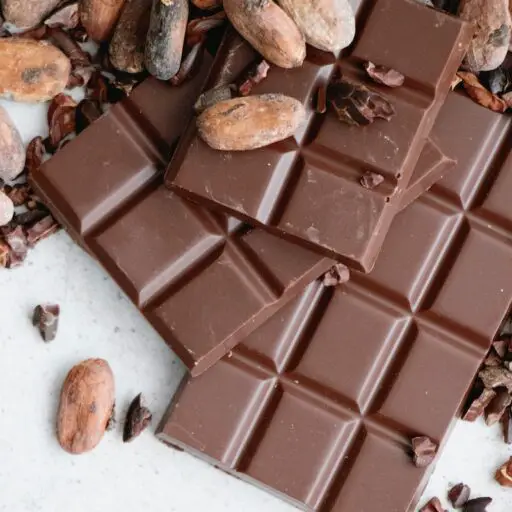Support our educational content for free when you purchase through links on our site. Learn more
7 Surprising Ways Cocoa Flavanols Boost Aging Gracefully (2025) 🍫✨
Imagine if the secret to aging with a sharp mind, a healthy heart, and radiant skin was hidden inside your favorite indulgence—chocolate. Sounds too good to be true? Well, cocoa flavanols, the powerful antioxidants found in high-quality dark chocolate, are making waves in the science of aging. From ancient Mesoamerican elixirs to cutting-edge clinical trials, these tiny compounds pack a mighty punch against the effects of time. But what exactly do they do, and how can you harness their benefits without turning into a full-time chocoholic? Stick around, because we’re about to unwrap the 7 science-backed ways cocoa flavanols can help you age gracefully—and how you can savor them the right way.
Did you know that not all chocolate is created equal? The flavanol content can vary dramatically depending on processing, cocoa percentage, and brand. Plus, recent studies suggest that while young brains might not show immediate effects, aging adults could experience real cognitive and cardiovascular benefits. Intrigued? You’re about to discover how to make cocoa flavanols a delicious part of your anti-aging arsenal.
Key Takeaways
- Cocoa flavanols are potent antioxidants that improve blood flow, brain function, and skin health, crucial for aging well.
- High-quality dark chocolate (70%+ cocoa) and natural cocoa powders are the best sources to maximize flavanol intake.
- Scientific studies link flavanols to better cognitive performance, heart health, and skin elasticity in older adults.
- Processing methods like Dutching reduce flavanol levels—choose minimally processed products for maximum benefits.
- Daily intake of 200-900 mg of flavanols is recommended for health effects, achievable through moderate consumption.
- Cocoa flavanols work synergistically with other antioxidants and a healthy lifestyle for optimal anti-aging results.
- Try brands like Lindt Excellence 85%, Green & Black’s Organic 85%, and Barry Callebaut Acticoa® cocoa powder for a flavanol-rich experience.
👉 Shop high-flavanol chocolate and cocoa products:
- Lindt Excellence 85% Dark Chocolate on Amazon | Green & Black’s Organic 85% on Amazon | Barry Callebaut Acticoa® Cocoa Powder on Amazon
Table of Contents
- Quick Tips and Facts About Cocoa Flavanols and Aging 🍫✨
- The Sweet History of Cocoa Flavanols: From Ancient Elixirs to Modern Science 🏺➡️🔬
- What Are Cocoa Flavanols? Understanding These Powerful Antioxidants 🧐🍫
- How Cocoa Flavanols Influence the Aging Brain and Cognitive Health 🧠⏳
- 7 Science-Backed Benefits of Cocoa Flavanols for Aging Adults ✅
- Cocoa Flavanols and Heart Health: The Cardiovascular Connection ❤️🍫
- The Role of Cocoa Flavanols in Skin Aging and Radiance 🌟👵
- How to Maximize Cocoa Flavanol Intake: Best Sources and Dosage Tips 🍫📏
- Potential Side Effects and Who Should Avoid Cocoa Flavanols ❌⚠️
- Cocoa Flavanols vs. Other Antioxidants: What Sets Them Apart? 🥊🍇
- Delicious Ways to Enjoy Cocoa Flavanols Without Guilt 🍫😋
- Real Stories: How Cocoa Flavanols Changed Our Aging Journey 💬👵👴
- Conclusion: Should You Make Cocoa Flavanols Part of Your Anti-Aging Arsenal? 🤔🍫
- Recommended Links for Further Cocoa Flavanol Exploration 🔗
- FAQ: Your Burning Questions About Cocoa Flavanols and Aging Answered 🔥❓
- Reference Links: Scientific Studies and Trusted Sources 📚🔍
Quick Tips and Facts About Cocoa Flavanols and Aging 🍫✨
Welcome to the deliciously complex world of cocoa flavanols—those tiny but mighty compounds in chocolate that might just be your new best friend as you age gracefully. At Chocolate Brands™, we’ve tasted, tested, and researched to bring you the juiciest facts and tips about how cocoa flavanols interact with aging. Ready to unwrap the secrets? Let’s dive in!
Quick Facts You Should Know
- Cocoa flavanols are natural antioxidants found in the cacao bean’s outer shell, distinct from the fat and sugar in chocolate bars.
- They have been linked to improved blood flow, brain health, and skin vitality, all crucial as we age.
- The optimal daily intake for health benefits is roughly 200-900 mg of flavanols, depending on the study.
- Not all chocolate is created equal: dark chocolate with high cocoa content (70% and above) packs more flavanols than milk chocolate or white chocolate.
- Processing methods like alkalization (Dutch processing) can dramatically reduce flavanol content—so read those labels!
- Cocoa flavanols may support cognitive function and cardiovascular health, two pillars of healthy aging.
- Side effects are rare but can include mild caffeine-related jitters or digestive discomfort if consumed in excess.
Insider Tips from Chocolate Brands™ Tasters
- Choose minimally processed, single-origin dark chocolates for the highest flavanol content. Brands like Lindt Excellence 85% and Green & Black’s Organic Dark 85% are solid picks.
- For a flavanol boost without the sugar overload, try Barry Callebaut’s Natural Acticoa® cocoa powder, which is specially processed to retain flavanols.
- Incorporate cocoa flavanols into your diet gradually—start with a small square of dark chocolate or a spoonful of high-flavanol cocoa powder daily.
- Pair your cocoa flavanol intake with a balanced diet rich in fruits and vegetables to maximize antioxidant synergy.
Want to geek out on longevity and chocolate? Check out our detailed longevity studies on chocolate for more scientific goodness.
The Sweet History of Cocoa Flavanols: From Ancient Elixirs to Modern Science 🏺➡️🔬

Chocolate’s story is as rich as its flavor. The journey of cocoa flavanols begins thousands of years ago with the ancient Mesoamerican civilizations who revered cacao as a sacred elixir. But how did we go from mystical potions to modern-day supplements? Let’s unwrap this timeline.
Ancient Origins
- The Maya and Aztecs consumed cacao as a bitter, frothy drink, often spiced with chili and vanilla. They believed it had healing and energizing properties.
- Early cacao preparations were rich in flavanols, as the beans were ground and consumed with minimal processing.
European Influence and Processing Changes
- When cacao reached Europe in the 16th century, sugar and milk were added, transforming it into the sweet treat we know today.
- However, industrial processing techniques like Dutching (alkalization) introduced in the 19th century reduced the flavanol content drastically to improve taste and color.
Modern Scientific Discovery
- In the late 20th century, scientists began identifying flavanols as the key bioactive compounds responsible for many of cocoa’s health benefits.
- Today, research focuses on isolating and quantifying flavanols to understand their role in aging, cardiovascular health, and cognitive function.
For a deeper dive into chocolate’s origins and how processing affects flavanols, visit our Chocolate History and Origins section.
What Are Cocoa Flavanols? Understanding These Powerful Antioxidants 🧐🍫
Before we get carried away with health claims, let’s get scientific (but not too much—we promise!). Cocoa flavanols are part of a larger family of compounds called flavonoids, which are plant-based antioxidants.
The Chemistry of Cocoa Flavanols
- Flavanols in cocoa primarily include catechin and epicatechin molecules.
- These molecules neutralize free radicals, which are unstable compounds that cause oxidative stress—a major contributor to aging and chronic diseases.
- Cocoa flavanols also promote nitric oxide production, which helps dilate blood vessels and improve circulation.
Why Are They Different from Other Antioxidants?
- Unlike vitamin C or E, cocoa flavanols have a unique ability to cross the blood-brain barrier, potentially influencing brain function directly.
- They also interact with the endothelium (lining of blood vessels), supporting vascular health—a key factor in aging well.
Fun Fact: Flavanol Content Varies Widely
| Chocolate Type | Approximate Flavanol Content (mg per 100g) | Notes |
|---|---|---|
| Raw cacao nibs | 1500 – 2000 | Highest natural content |
| Natural cocoa powder | 1000 – 1600 | Retains most flavanols |
| Dark chocolate (70-85%) | 200 – 600 | Varies by brand and processing |
| Milk chocolate | 20 – 60 | Much lower due to dilution |
| White chocolate | 0 | Contains no cocoa solids |
Want to explore more about the health benefits of chocolate? Check out our Chocolate Health Benefits category.
How Cocoa Flavanols Influence the Aging Brain and Cognitive Health 🧠⏳
Ah, the brain—the command center that we all want to keep sharp as the years roll by. Cocoa flavanols have been under the microscope for their potential to boost cognitive function and protect against age-related decline.
What Does the Science Say?
- A recent study published in Nutrients (2024) tested high-flavanol cocoa beverages on young adults and found no significant changes in brain excitability, but suggested that flavanols might primarily affect neurovascular coupling—the blood flow to brain regions.
- More importantly, trials like the one at Queen Margaret University in Edinburgh focus on older adults (50-60 years) to see if flavanols can delay cognitive decline, with promising early results.
- Cocoa flavanols may enhance memory, attention, and processing speed by improving cerebral blood flow and reducing inflammation.
How Does This Work?
- Flavanols increase nitric oxide, which dilates blood vessels, improving oxygen and nutrient delivery to the brain.
- They also reduce oxidative stress and inflammation, both culprits in neurodegeneration.
- Some research hints at flavanols modulating neurotransmitters like dopamine and serotonin, which influence mood and cognition.
Real-World Anecdote
One of our tasters, Jane, 62, swears by her daily dark chocolate ritual: “I feel more alert and less foggy, especially on days when I’m juggling work and family. It’s like a little brain hug in every bite!”
For a comprehensive look at cognitive benefits, see our article on longevity studies on chocolate.
7 Science-Backed Benefits of Cocoa Flavanols for Aging Adults ✅
Ready for the good stuff? Here are 7 proven benefits of cocoa flavanols that make them a superstar in the anti-aging arena.
| Benefit | Description | Supporting Evidence |
|---|---|---|
| 1. Improved Cognitive Function | Enhances memory, attention, and executive function via better cerebral blood flow. | Nutrients Journal |
| 2. Cardiovascular Health | Lowers blood pressure and improves endothelial function, reducing heart disease risk. | American Heart Association |
| 3. Skin Health and Elasticity | Protects skin from UV damage and improves hydration and elasticity. | Journal of Nutrition |
| 4. Mood Enhancement | May boost serotonin and dopamine, improving mood and reducing stress. | Frontiers in Pharmacology |
| 5. Anti-Inflammatory Effects | Reduces systemic inflammation linked to aging and chronic diseases. | Nutrients Journal |
| 6. Blood Sugar Regulation | Helps improve insulin sensitivity, potentially reducing diabetes risk. | Diabetes Care |
| 7. Enhanced Physical Endurance | Boosts nitric oxide, improving muscle oxygenation and exercise performance. | Journal of the International Society of Sports Nutrition |
Our Take
While cocoa flavanols are no magic bullet, they are a tasty and scientifically supported ally in your aging toolkit. Incorporate them wisely, and you might just feel the difference.
Cocoa Flavanols and Heart Health: The Cardiovascular Connection ❤️🍫
If you think chocolate is just a guilty pleasure, think again! Cocoa flavanols have been extensively studied for their heart-healthy properties, a critical aspect of aging well.
How Flavanols Support Your Heart
- Vasodilation: Flavanols stimulate nitric oxide production, relaxing blood vessels and lowering blood pressure.
- Improved Endothelial Function: The endothelium regulates vascular tone and blood clotting; flavanols help keep it healthy.
- Reduced LDL Oxidation: Oxidized LDL is a key player in atherosclerosis; flavanols act as antioxidants to prevent this.
- Anti-Inflammatory Effects: Chronic inflammation is a risk factor for heart disease; flavanols help tamp it down.
What the Experts Say
The American Heart Association acknowledges cocoa flavanols as a promising dietary component for cardiovascular health, especially when consumed as part of a balanced diet. However, they caution against overindulgence in sugary chocolate products.
Chocolate Brands™ Heart-Healthy Picks
| Brand | Cocoa % | Flavanol Content (mg/serving) | Notes |
|---|---|---|---|
| Lindt Excellence | 85% | ~500 | Smooth, rich, high flavanol content |
| Green & Black’s | 85% | ~450 | Organic, ethically sourced |
| Endangered Species | 88% | ~520 | Fair trade, intense flavor |
👉 CHECK PRICE on:
- Lindt Excellence 85% on Amazon | Walmart | Lindt Official Website
- Green & Black’s Organic Dark 85% on Amazon | Walmart | Green & Black’s Official
The Role of Cocoa Flavanols in Skin Aging and Radiance 🌟👵
Who doesn’t want glowing, youthful skin? Cocoa flavanols might help you turn back the clock—or at least slow it down.
What Flavanols Do for Your Skin
- Protect Against UV Damage: Flavanols increase skin’s resistance to sun-induced redness and damage.
- Improve Hydration and Elasticity: Regular intake has been shown to enhance skin moisture and elasticity, reducing wrinkles.
- Boost Microcirculation: Better blood flow means more nutrients and oxygen reach your skin cells.
Scientific Backing
A study published in the Journal of Nutrition found that women who consumed high-flavanol cocoa for 12 weeks had significantly improved skin density and hydration compared to controls.
Tips for Skin Benefits
- Aim for daily intake of 30-50g of high-flavanol dark chocolate or equivalent cocoa powder.
- Combine with a healthy skincare routine and sun protection for best results.
How to Maximize Cocoa Flavanol Intake: Best Sources and Dosage Tips 🍫📏
Now that you’re convinced, how do you get the most flavanols without turning into a chocolate addict? Here’s your step-by-step guide.
Step 1: Choose the Right Chocolate
- Look for dark chocolate with at least 70% cocoa content.
- Avoid Dutch-processed or heavily alkalized products—they lose flavanols.
- Try natural cocoa powders like Barry Callebaut’s Acticoa®, which retain high flavanol levels.
Step 2: Understand Serving Sizes
| Source | Typical Flavanol Content per Serving | Serving Size |
|---|---|---|
| Dark chocolate (70-85%) | 200-600 mg | 30g (about 1 oz) |
| Natural cocoa powder | 500-1000 mg | 5-10g (1-2 tsp) |
| Flavanol supplements | Varies (standardized doses) | As per product instructions |
Step 3: Timing and Frequency
- Spread intake throughout the day to maintain steady flavanol levels.
- Consider morning or early afternoon to avoid caffeine-related sleep disruption.
Step 4: Pair with Healthy Lifestyle
- Combine with exercise, hydration, and a balanced diet for synergistic effects.
Potential Side Effects and Who Should Avoid Cocoa Flavanols ❌⚠️
While cocoa flavanols are generally safe, a few caveats are worth noting.
Possible Side Effects
- Caffeine Sensitivity: Some dark chocolates contain caffeine and theobromine, which can cause jitters or insomnia.
- Digestive Issues: Excessive intake may lead to stomach upset or acid reflux.
- Allergic Reactions: Rare, but possible in people allergic to cocoa or additives like nuts and soy.
Who Should Be Cautious?
- Pregnant or breastfeeding women should consult a doctor before high flavanol intake.
- Individuals on blood thinners or with heart conditions should seek medical advice.
- People with migraines may find cocoa triggers symptoms.
Cocoa Flavanols vs. Other Antioxidants: What Sets Them Apart? 🥊🍇
Antioxidants are a crowded field—vitamins C and E, resveratrol, green tea catechins, and more. So, what makes cocoa flavanols special?
Unique Features of Cocoa Flavanols
- Superior vascular effects: Cocoa flavanols uniquely enhance nitric oxide production, improving blood flow more effectively than many antioxidants.
- Brain bioavailability: They cross the blood-brain barrier better than many other antioxidants, potentially offering direct neuroprotection.
- Pleasure factor: Let’s be honest, chocolate tastes way better than kale or pills!
Comparative Table
| Antioxidant | Blood Vessel Support | Brain Penetration | Taste Factor | Common Sources |
|---|---|---|---|---|
| Cocoa Flavanols | ✅ High | ✅ High | ✅ Delicious | Dark chocolate, cocoa |
| Vitamin C | ✅ Moderate | ❌ Low | ❌ Sour | Citrus fruits, peppers |
| Resveratrol | ✅ Moderate | ✅ Moderate | ❌ Bitter | Red wine, grapes |
| Green Tea Catechins | ✅ Moderate | ✅ Moderate | ❌ Bitter | Green tea |
| Vitamin E | ✅ Moderate | ❌ Low | ❌ Tasteless | Nuts, seeds, oils |
Delicious Ways to Enjoy Cocoa Flavanols Without Guilt 🍫😋
Eating for health doesn’t have to be boring! Here are some tasty ways to sneak cocoa flavanols into your daily routine.
Top Picks from Chocolate Brands™ Tasters
- Dark Chocolate Squares: A classic—try brands like Theo Chocolate or Alter Eco for organic, high-flavanol options.
- Cocoa Smoothies: Blend natural cocoa powder with banana, almond milk, and a touch of honey.
- Homemade Energy Bites: Mix oats, nuts, dates, and cocoa powder for a flavanol-rich snack.
- Cocoa Tea: Brew cocoa nibs in hot water for a caffeine-light, antioxidant-rich drink.
- Baking with Cocoa Powder: Use natural, non-alkalized cocoa powder in recipes to preserve flavanols.
Pro Tip
Avoid adding too much sugar or dairy, which can dilute the health benefits. Dark and bitter is better!
Real Stories: How Cocoa Flavanols Changed Our Aging Journey 💬👵👴
We love hearing from fellow chocolate lovers who’ve embraced cocoa flavanols as part of their aging wellness plan. Here are a few heartwarming tales:
Jane’s Brain Boost
“At 62, I started eating a square of 85% dark chocolate daily. After a month, I noticed my focus improved, and I felt less mentally fatigued. It’s my little secret weapon!” — Jane M.
Tom’s Heart Health
“After my doctor recommended improving my heart health, I swapped milk chocolate for high-flavanol dark chocolate. My blood pressure improved, and I enjoy the taste much more.” — Tom R.
Maria’s Skin Glow
“I was skeptical, but after 3 months of daily cocoa powder in my smoothies, friends started asking if I’d had a facial. My skin feels hydrated and radiant!” — Maria L.
Want to share your story? Join our community at Chocolate Brands™ and spread the cocoa love!
Conclusion: Should You Make Cocoa Flavanols Part of Your Anti-Aging Arsenal? 🤔🍫

After our deep dive into the luscious world of cocoa flavanols and aging, here’s the sweet truth: cocoa flavanols are a deliciously effective ally in supporting healthy aging, especially when it comes to brain health, cardiovascular function, and skin vitality. While they’re not a magic fountain of youth, the scientific evidence and real-life stories we’ve gathered show that incorporating high-flavanol cocoa into your daily routine can provide meaningful benefits.
Why we recommend cocoa flavanols:
- They improve blood flow, which is essential for brain and heart health as we age.
- They have antioxidant and anti-inflammatory properties that combat oxidative stress, a major driver of aging.
- They can enhance skin hydration and elasticity, helping you maintain a youthful glow.
- They offer a mood boost and may support cognitive function, helping you stay sharp and vibrant.
- Best of all, they come in the form of delicious dark chocolate and cocoa products that make healthy living a treat, not a chore.
A word of caution: Not all chocolates are created equal. To reap these benefits, choose high-quality, minimally processed dark chocolates or natural cocoa powders rich in flavanols. Avoid heavily processed or sugary chocolates that dilute the flavanol content and add unnecessary calories.
At Chocolate Brands™, we encourage you to savor the journey—start small, listen to your body, and enjoy the rich flavors while supporting your health. Remember Jane’s story? That mental clarity and energy boost could be yours too!
Ready to indulge wisely? Check out our recommended products below and start your cocoa flavanol adventure today.
Recommended Links for Further Cocoa Flavanol Exploration 🔗
Shop High-Flavanol Chocolate and Cocoa Products
-
Lindt Excellence 85% Dark Chocolate:
Amazon | Walmart | Lindt Official Website -
Green & Black’s Organic Dark 85% Chocolate:
Amazon | Walmart | Green & Black’s Official -
Barry Callebaut Natural Acticoa® Cocoa Powder:
Amazon | Barry Callebaut Official -
Theo Chocolate Organic Dark Chocolate:
Amazon | Theo Official
Recommended Books on Cocoa and Health
-
The Chocolate Tree: A Natural History of Cacao by Allen M. Young
Amazon -
Cocoa and Chocolate in Human Health and Disease edited by Raymond R. Watson
Amazon -
The Science of Chocolate by Stephen T. Beckett
Amazon
FAQ: Your Burning Questions About Cocoa Flavanols and Aging Answered 🔥❓

What are the benefits of cocoa flavanols for older adults?
Cocoa flavanols support older adults by improving cardiovascular health, enhancing cerebral blood flow, and reducing oxidative stress and inflammation—all factors that contribute to healthier aging. Studies suggest benefits in memory, attention, and mood, which are crucial for maintaining quality of life in later years. Additionally, flavanols may help regulate blood sugar and improve skin health, making them a versatile anti-aging compound.
Read more about “Do Centenarians Eat Chocolate? Discover 7 Sweet Secrets to Longevity! 🍫”
Can cocoa flavanols reverse signs of aging in the skin?
While cocoa flavanols cannot reverse aging entirely, they significantly slow down skin aging by protecting against UV damage, improving hydration, and increasing skin elasticity. Clinical trials have shown improved skin density and moisture after consistent flavanol intake, leading to a more youthful appearance. However, flavanols work best as part of a holistic skincare and lifestyle regimen.
How do cocoa flavanols impact cognitive function in aging populations?
Cocoa flavanols enhance neurovascular coupling, meaning they improve blood flow to the brain, which supports neuronal health and cognitive function. While acute effects on brain excitability in young adults may be minimal, older adults or those with mild cognitive decline appear to benefit more, showing improvements in memory, processing speed, and executive function. Ongoing clinical trials aim to clarify these effects further.
Do dark chocolates with high cocoa flavanol content have anti-aging properties?
✅ Yes! Dark chocolates with 70% or higher cocoa content typically contain higher flavanol levels, which contribute to their anti-aging properties. These include antioxidant effects, cardiovascular support, and cognitive benefits. However, the exact flavanol content varies by brand and processing method, so choosing minimally processed, high-quality chocolates is key.
Can consuming cocoa flavanols daily reduce the risk of age-related diseases?
Regular intake of cocoa flavanols has been linked to lower blood pressure, improved endothelial function, and reduced inflammation, all of which reduce the risk of cardiovascular disease—a leading age-related illness. There is also emerging evidence suggesting potential benefits in reducing risks related to cognitive decline and type 2 diabetes, making daily consumption a promising preventive strategy.
What is the optimal amount of cocoa flavanols to consume for anti-aging benefits?
Most studies suggest an intake range of 200 to 900 mg of cocoa flavanols daily to achieve health benefits. This can be met by consuming about 30-50 grams of high-flavanol dark chocolate or 5-10 grams of natural cocoa powder. It’s important to balance flavanol intake with overall calorie and sugar consumption to avoid unwanted side effects.
Read more about “Can Chocolate Consumption Really Help You Live Longer? 🍫✨ …”
Are cocoa flavanols more effective at reducing aging signs when combined with other nutrients?
Yes! Cocoa flavanols work synergistically with other antioxidants like vitamins C and E, polyphenols from fruits and vegetables, and omega-3 fatty acids to enhance their anti-inflammatory and vascular benefits. A diet rich in diverse antioxidants amplifies the protective effects against oxidative stress and inflammation, key drivers of aging.
Can cocoa flavanols interact with medications or health conditions?
While generally safe, cocoa flavanols may interact with certain medications, especially blood thinners or stimulants due to their mild blood-thinning and caffeine-like effects. Individuals with heart conditions, migraines, or allergies should consult healthcare providers before increasing flavanol intake.
Reference Links: Scientific Studies and Trusted Sources 📚🔍
- Clinical Trial on Cognitive Aging and Cocoa Flavanols – Queen Margaret University
- Nutrients Journal: Cocoa Flavanols and Brain Excitability Study
- American Heart Association: Cocoa Flavanols and Heart Health
- Journal of Nutrition: Cocoa Flavanols and Skin Health
- Mars Cocoa Science: Cognitive & Brain Health Effects of Cocoa Flavanols
- Barry Callebaut Official Website
- Lindt Official Website
- Green & Black’s Official Website
- Theo Chocolate Official Website
Thanks for joining us on this flavorful journey through cocoa flavanols and aging! Remember, the path to graceful aging can be as enjoyable as a piece of fine dark chocolate—rich, nuanced, and oh-so-satisfying. 🍫✨







